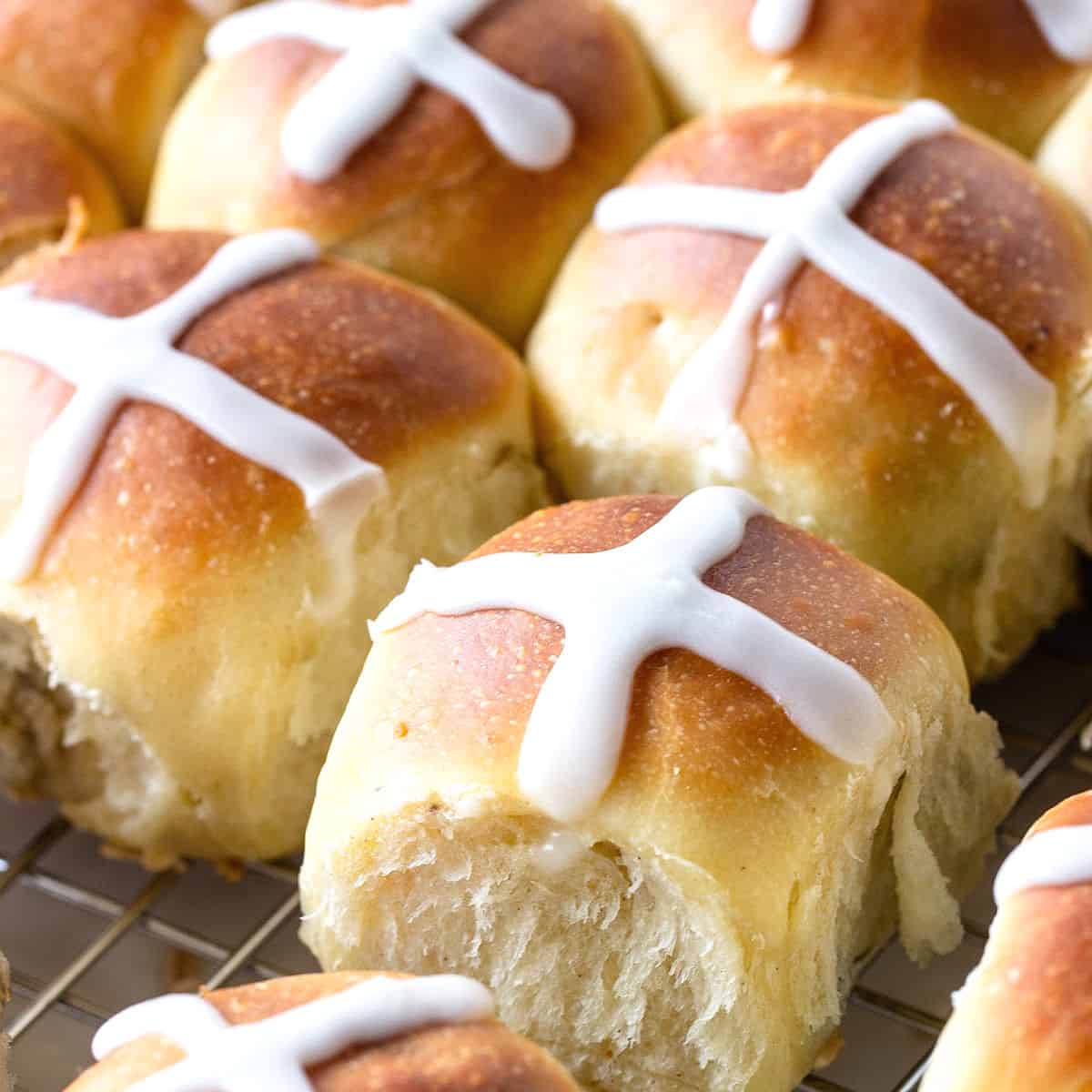Easy Hot Cross Buns
5.0
(16)
Your folders
Your folders
Prep Time: 30 minutes
Cook Time: 20 minutes
Total: 185 minutes
Servings: 15

Ingredients
Export 9 ingredients for grocery delivery
Instructions
Step 1
Line 9x13-inch baking pan with high sides, spray with oil, and dust lightly with oats or flour. Do not use a baking sheet for these buns as they need sides to contain them and rise upwards and not to the sides.
Step 2
Place 4 teaspoons active dry yeast and ¼ cup warm water in the bowl of a stand mixer and stir to dissolve with a fork or spoon. Allow to stand for about 3 minutes until it foams and maybe large bubbles form. If this doesn't happen your yeast is not active as it should be. You need to buy fresh and start again.
Step 3
Add ½ cup warm milk, ½ cup sunflower oil, ⅓ cup granulated sugar and 1 cup of flour to the yeast mixture and stir with a fork or spoon to combine.
Step 4
Add ½ teaspoon ground cinnamon and ¼ teaspoon grated nutmeg, stirring with a wire whisk until the ingredients are well combined.
Step 5
Add 1 teaspoon salt and 3 large eggs and mix well.
Step 6
Attach bowl to the mixer fitted with the dough hook and gradually add 2 ½ to 3 cups flour, ½ cup at a time, while kneading on medium-low speed until it all mixed well.
Step 7
On medium speed, knead for 5 to 7 minutes. The dough will be wet and sticky but will start to come together. I added about ¼ cup more flour. Cover the bowl with plastic wrap and let rest for 20 minutes.
Step 8
Knead the dough for 1 or 2 more minutes, or until it becomes smooth, supple, and elastic but not too firm. Transfer to a lightly floured surface and, with your hands lightly floured also, stretch into a rectangle. It will be sticky but workable.
Step 9
Spread ⅔ cup dried currants or raisins evenly over the rectangle. Fold the whole mass like an envelope and knead it gently until the currants are well distributed, about 2 to 3 minutes. Some of the currants may pop out of the dough; incorporate them again.
Step 10
Shape the dough into a loose ball and place it in a lightly oiled or greased bowl. Turn to coat the top of the dough with oil and cover the bowl with plastic wrap, a lid or a dry kitchen towel.
Step 11
Let the dough rise at warm room temperature until doubled in volume, about 1 ½ to 2 hours. If, after a half hour the dough is barely moving, cover it with a blanket or even a sweater so that it has enough temperature to rise. See Notes, below, for overnight rising.
Step 12
When the dough has doubled, gently deflate it with your closed fist and turn it onto a clean work surface, pressing in any loose currants. You probably won't need to lightly flour the counter, but you can it if it's sticking too much that that makes it hard to work with.
Step 13
Flour your hands lightly and divide the dough into 15 pieces or so (each weighing about 2 ounces or 50g).
Step 14
Shape the rolls, cupping the pieces with your rounded palm and making circular movements until you have a rounded bun. There's a video clip in the post above showing how this is done.
Step 15
Place them on the prepared pan, leaving about a half-inch space between them. Cover them loosely with oiled plastic wrap or a dry kitchen towel and let them rise at room temperature until almost doubled in volume, about 45 minutes to 1 hour.
Step 16
About 15 minutes before you're ready to bake, preheat the oven to 350ºF / 180ºC.
Step 17
If you like to brush with egg wash (for a shinier surface), see Notes below.
Step 18
When the buns have doubled, bake them for 15-20 minutes or until the buns have turned a nice golden brown and the surface feels slightly firm but not hard when you press it lightly. These rolls should have a thin soft covering, not a hard crunchy crust.
Step 19
Transfer the rolls to a rack and let them cool for 5 minutes.
Step 20
Carefully slide a smooth-bladed knife along the sides to make sure they're not stuck, and carefully remove them onto a wire rack. Let cool for 10 more minutes before making the crosses on top.
Step 21
While the buns are cooling, make the frosting by mixing ¾ cup powdered sugar with 2 teaspoons milk in a small bowl. It should be very thick. If you feel you need more liquid, add it in drops (literally).
Step 22
Put on a pastry bag, fitted with a small plain tip, or don't use a tip and simply cut the plastic bag, or a teaspoon, to make an X of frosting over the cross of each bun. The frosting will harden somewhat as the buns cool.
Step 23
They are best eaten the same day they are baked.
Step 24
Store leftovers at room temperature in a plastic bag or airtight container, and warm slightly before eating. Or freeze them, wrapped in plastic first and then in foil. Thaw at room temperature before serving. And warm in a medium oven before eating.